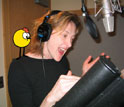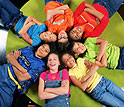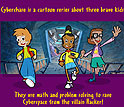|

Press Release 04-064
Television That's Good for You

Targeted content and celebrity voices draw millions to new season of educational children's television
May 4, 2004
ARLINGTON, Va.—With huge audiences, popular websites and even vocal talent lent from Hollywood, educational programs are major players in the 2004 children's television season. Supported by the National Science Foundation (NSF), three of the most-viewed programs – ZOOM, Cyberchase and DragonflyTV – now share the airwaves with PEEP and the Big Wide World, a novel show that teaches toddlers to think like scientists.
"The response of children and parents to these popular TV programs sends a clear message. They want to watch intelligent, engaging and educational TV," says Barry Van Deman, section head for science literacy in NSF's Division of Elementary, Secondary and Informal Education.
Actress Joan Cusack narrates WGBH's PEEP, a show that breaks new ground by teaching toddlers basic science concepts and skills like measuring, comparing and estimating. Young viewers follow a baby chicken named Peep, a robin named Chirp and a duck named Quack as the cartoon friends investigate mysterious animal tracks, discover shadows, learn the truths of gravity and otherwise explore their world. The program also has two aspects that parents can appreciate: the animation is based on the original artwork of Oscar-nominated, Danish animator Kaj Pindal and the theme song is performed by Blues legend Taj Mahal.
Thirteen/WNET's Cyberchase also boasts star power, from Gilbert Gottfried to Christopher Lloyd. The mystery-adventure cartoon is a vehicle for teaching mathematics and problem-solving, with action centering around three kids and their avian sidekick Digit (voiced by Gottfried). The kids use mathematics to foil their nemesis, Hacker (voiced Lloyd), at times encountering new characters voiced by special guests including Jane Curtin, Jasmine Guy and Al Roker. Despite its cartoon adventure feel, the program content relies upon extensive research into how kids learn and perform mathematics. Now reaching a cumulative audience of nearly 5 million viewers each week, Cyberchase is among the top-rated PBS KIDS afternoon programs in many large markets.
Entering its sixth season, ZOOM, also produced by WGBH, engages kids in science and engineering activities. Based on the popular 1970s television series, ZOOM re-emerged in the late 1990s with a new focus on science. The show is hosted by a diverse group of seven kids who explore ideas submitted by viewers from across the country. After the television is turned off, kids can go to the ZOOM website with their families to learn how to do the day's experiments (and others) with common household items.
ZOOM has also highlighted engineering through its ZOOM into Engineering initiative, featuring themed television shows that coincide with National Engineers Week. The ZOOM website also teaches engineering concepts using online activities for kids, families and teachers. From the Egg Bungee Jump to the surprisingly-strong Paper Bridge, the activities introduce early engineering concepts in a kid-digestible format.
DragonflyTV, produced by Twin Cities Public Television, also encourages participation by kids, families and teachers by presenting a different experiment and scientific question during each show. Kids then submit their data online. Each weekly show introduces a new group of middle-school students from across the country as they conduct scientific investigations of favorite activities—from soccer-kicking experiments to studies of malformed frogs in back yards. New for Season 3, the show encourages young viewers to conduct a featured experiment from home each week, report data online, and ultimately learn the cumulative results on the next episode.
Cyberchase, ZOOM and DragonflyTV can be seen on public television stations across the country, and PEEP is available to viewers with cable or satellite service.
Cyberchase is a service mark of Thirteen/WNET New York.
DragonflyTV is a registered service mark of Twin Cities Public Television, Inc.
PEEP
For kids: http://www.peepandthebigwideworld.com/
For adults: http://www.peepandthebigwideworld.com/activities/
For media: http://pressroom.wgbh.org/pages/peep.html
NSF Support: From first season in 2004
Cyberchase
For kids: http://pbskids.org/cyberchase/
For adults: http://pbskids.org/cyberchase/parentsteachers/index.html
For media: http://www.thirteen.org/pressroom/search.php?keywords=Cyberchase&program_specific=yes
NSF Support: From first season in 2002
ZOOM
For kids: http://pbskids.org/zoom/index.shtml
ZOOM into Engineering: http://pbskids.org/zoom/grownups/engineering/
For adults: http://pbskids.org/zoom/too/
For media: http://pressroom.wgbh.org/pages/zoom.html
NSF Support: From first season in 1998
DragonflyTV
For kids: http://pbskids.org/dragonflytv/
For adults: http://pbskids.org/dragonflytv/teachersguide.html
For media: http://www.dftvpress.org/
NSF Support: From first season in 2002
-NSF-

Media Contacts
Josh Chamot, NSF (703) 292-7730 jchamot@nsf.gov
Amy Kunen Zall, WGBH (617) 300-5340 amy_zall@wgbh.org
Edward Gregory, Thirteen/WNET (212) 560-3021 Gregory@thirteen.org
Kristin Pederson, Twin Cities Public TV (651) 229-1288 KPederson@tpt.org
Program Contacts
Valentine Kass, NSF (703) 292-5095 vkass@nsf.gov

The National Science Foundation (NSF) is an independent federal agency that supports fundamental research and education across all fields of science and engineering. In fiscal year (FY) 2009, its budget is $9.5 billion, which includes $3.0 billion provided through the American Recovery and Reinvestment Act. NSF funds reach all 50 states through grants to over 1,900 universities and institutions. Each year, NSF receives about 44,400 competitive requests for funding, and makes over 11,500 new funding awards. NSF also awards over $400 million in professional and service contracts yearly.
 Get News Updates by Email Get News Updates by Email
Useful NSF Web Sites:
NSF Home Page: http://www.nsf.gov
NSF News: http://www.nsf.gov/news/
For the News Media: http://www.nsf.gov/news/newsroom.jsp
Science and Engineering Statistics: http://www.nsf.gov/statistics/
Awards Searches: http://www.nsf.gov/awardsearch/
| 






